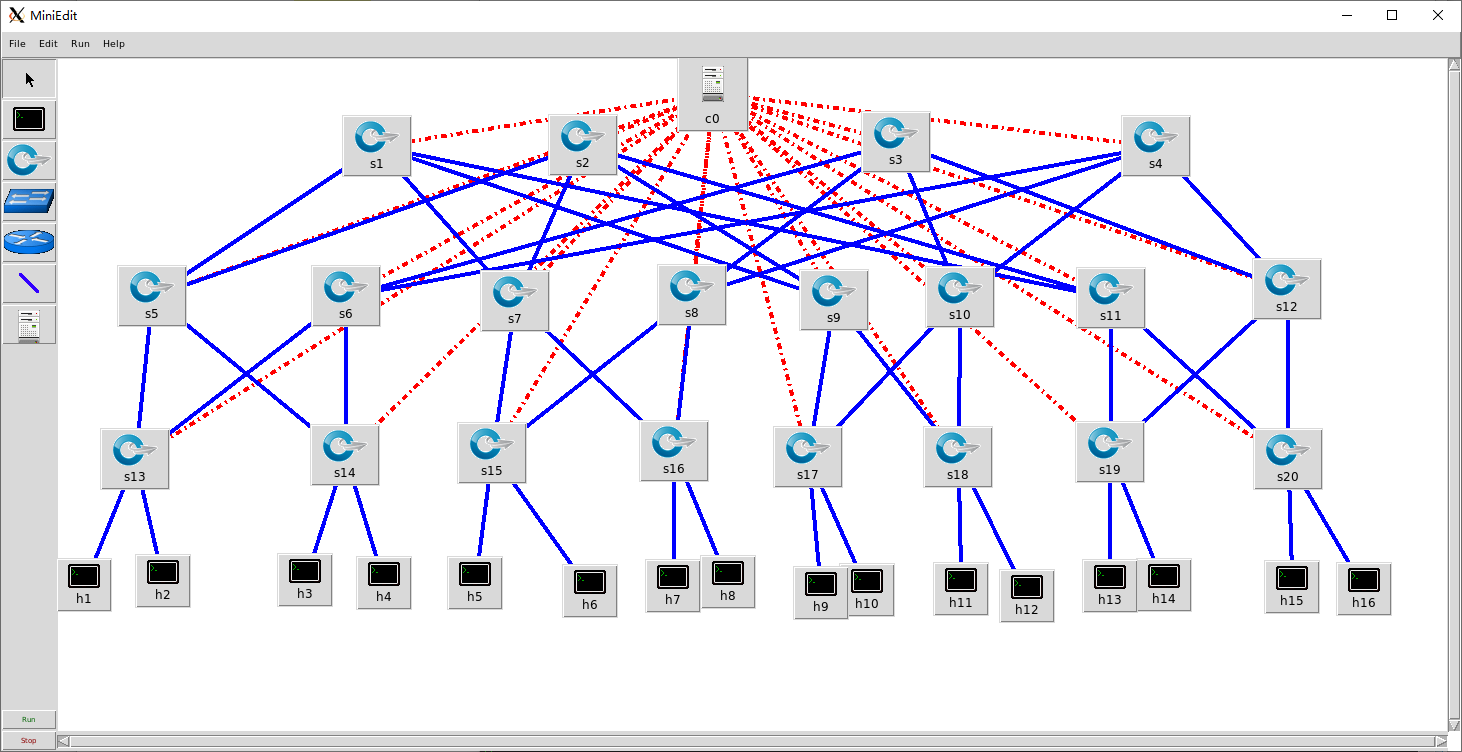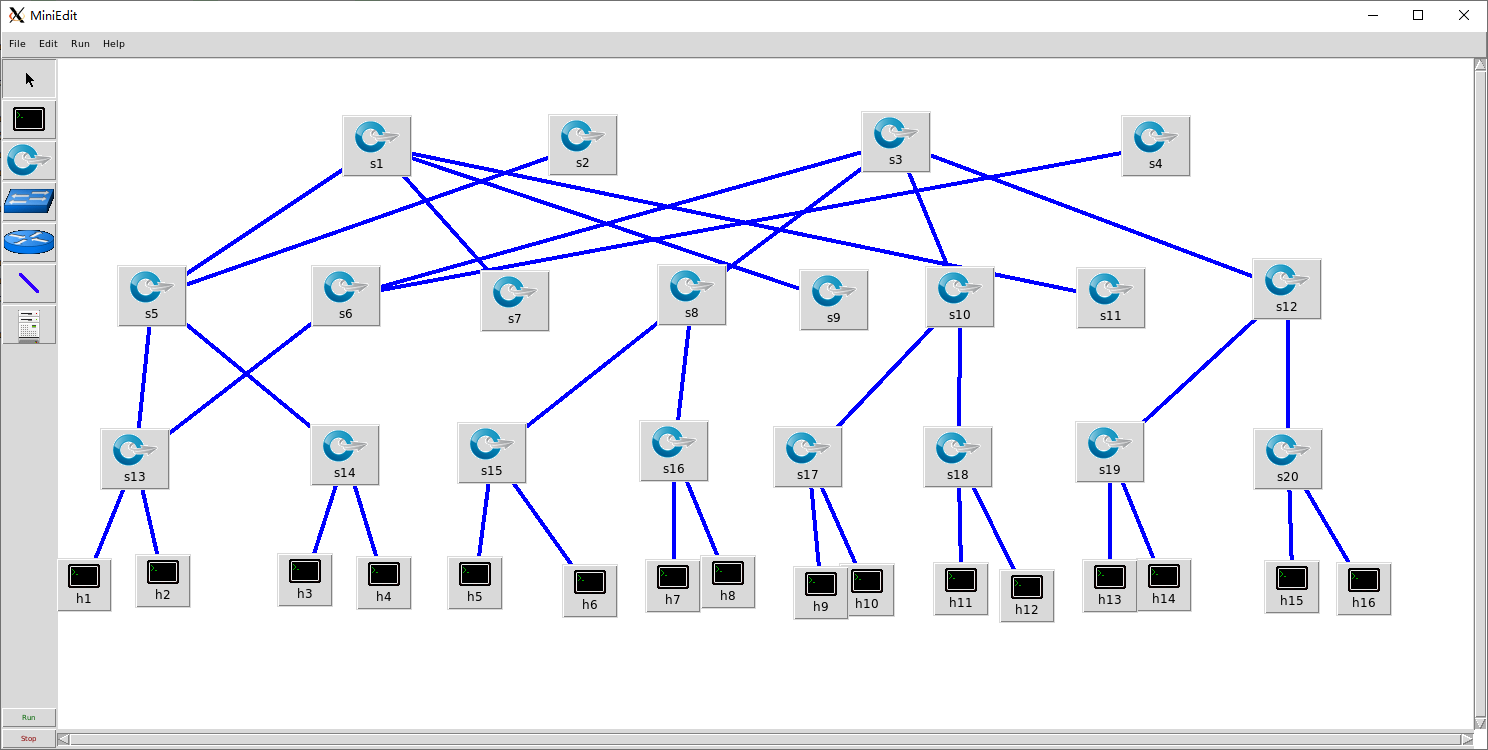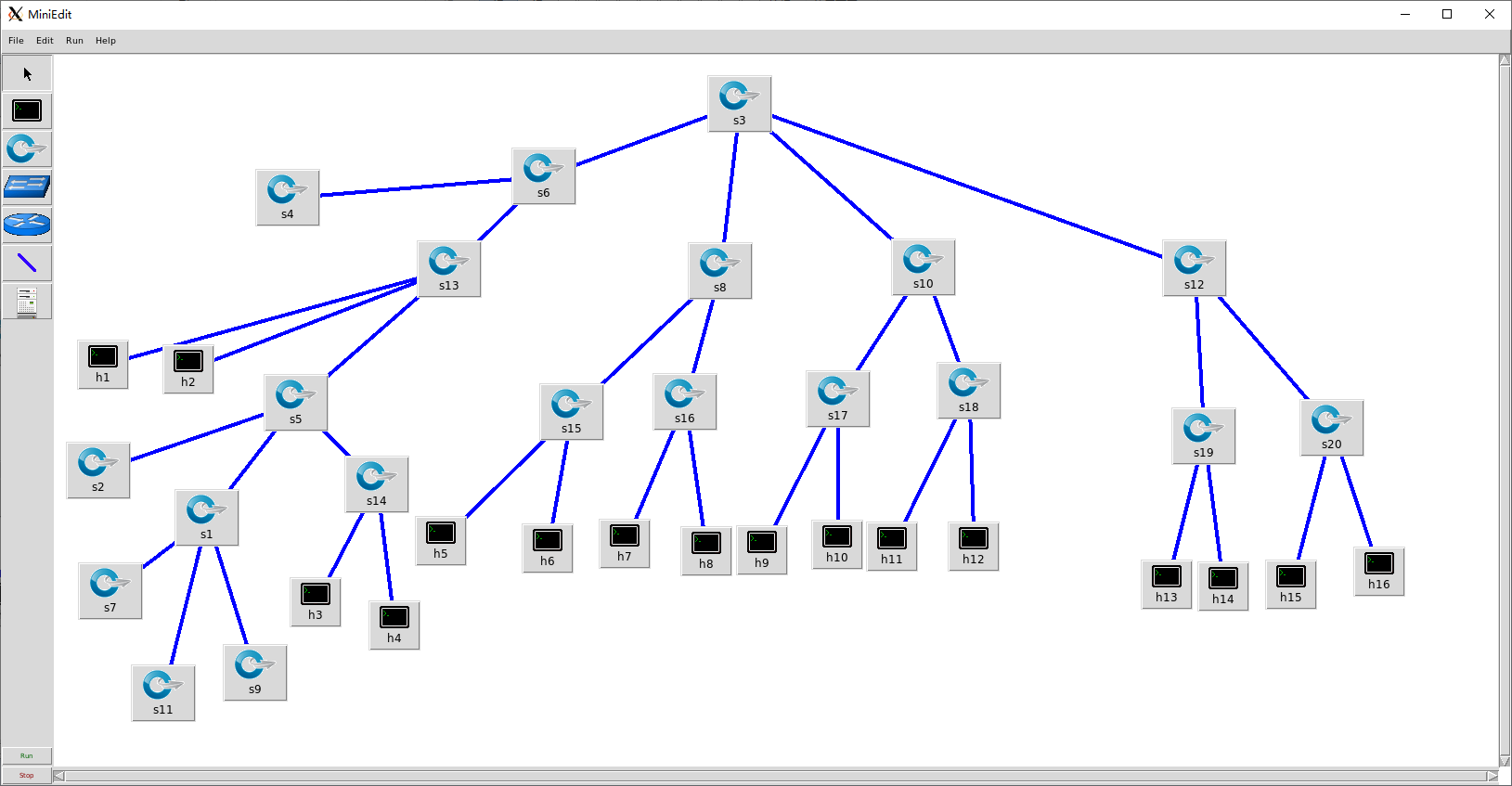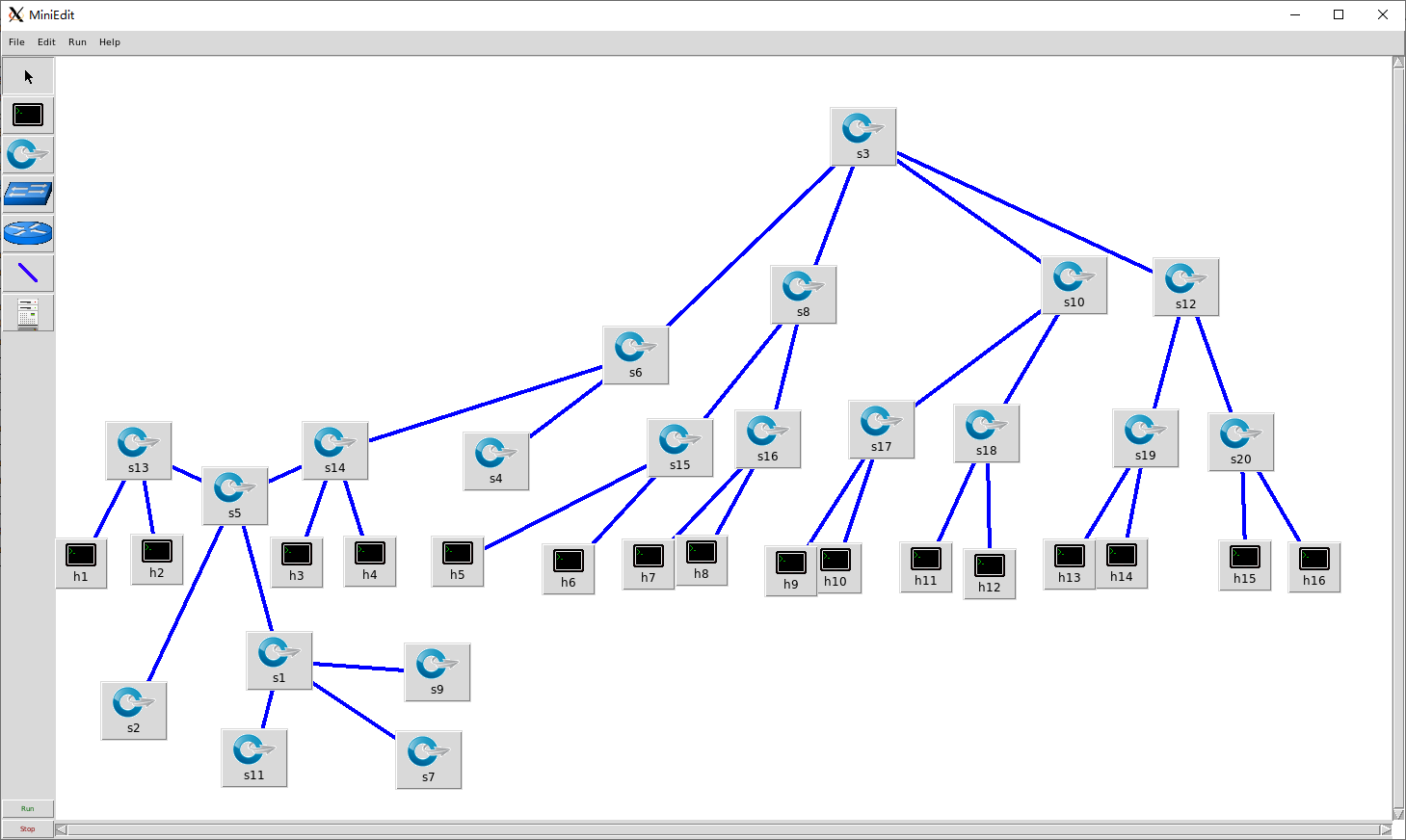report.md 8.0 KB
Datacenter Network Simulation using Mininet实验报告
陈翊辉
SA19011116
[toc]
FatTree拓扑
使用16个host的fatTree拓扑如下图:
在实验时,使用miniedit拖放绘制拓扑,ip不设置,导出python文件src/fattree.py
实验环境和文件说明
实验环境
由于硬件,系统兼容性和性能等一些原因,没有使用实验提供的虚拟机环境,使用了GitHub仓库release中最新的版本
mininet image:https://github.com/mininet/mininet/releases/download/2.2.2/mininet-2.2.2-170321-ubuntu-14.04.4-server-amd64.zip
linux:Linux mininet-vm 4.2.0-27-generic #32~14.04.1-Ubuntu SMP
Python:Python 2.7.6 (default, Oct 26 2016, 20:30:19) [GCC 4.8.4] on linux2
wireshark:Version 1.10.6
MiniNet: 2.2.2
vm:Oracle VM VirtualBox 6.1.8
文件说明
实验一 使用POX控制器
程序代码
完整代码见src
def myNetwork():
net = Mininet( topo=None,
build=False,
ipBase='10.0.0.0/8')
info( '*** Adding controller\n' )
c0=net.addController(name='c0',
controller=RemoteController,
ip='127.0.0.1',
protocol='tcp',
port=6633)
info( '*** Add switches\n')
s1 = net.addSwitch('s1', cls=OVSKernelSwitch)
# ......
s8 = net.addSwitch('s8', cls=OVSKernelSwitch)
info( '*** Add hosts\n')
h10 = net.addHost('h10', cls=Host, ip='10.0.0.10', defaultRoute=None)
# ......
h9 = net.addHost('h9', cls=Host, ip='10.0.0.9', defaultRoute=None)
info( '*** Add links\n')
net.addLink(s17, s1)
# ......
net.addLink(s20, s14)
info( '*** Starting network\n')
net.build()
info( '*** Starting controllers\n')
for controller in net.controllers:
controller.start()
info( '*** Starting switches\n')
net.get('s1').start([c0])
# ......
net.get('s8').start([c0])
info( '*** Post configure switches and hosts\n')
CLI(net)
net.stop()
启动后进入mininet的CLI,之后再进一步测试。
POX控制器设置
由于fattree拓扑结构中包含环,需要生成树(spanning tree),同时还需要learning,pox对两者支持都非常方便:
sudo ~/pox/pox.py forwarding.l2_learning \
openflow.spanning_tree --no-flood --hold-down \
log.level --DEBUG samples.pretty_log \
openflow.discovery host_tracker \
info.packet_dump
pingall测试
使用pingall测试结果,完整结果见result.txt
h10 -> h11 h4 h2 h13 h5 h16 h15 h14 h6 h7 h12 h8 h3 h1 h9
h11 -> h10 h4 h2 h13 h5 h16 h15 h14 h6 h7 h12 h8 h3 h1 h9
# ...
h9 -> h10 h11 h4 h2 h13 h5 h16 h15 h14 h6 h7 h12 h8 h3 h1
*** Results: 0% dropped (240/240 received)
可见所有主机之间可以连通
生成树结构
在上文的CLI环境中使用net和dpctl dump-ports-desc,输出如下,完整结果见result.txt
h10 h10-eth0:s11-eth4
h11 h11-eth0:s12-eth3
# ......
h9 h9-eth0:s11-eth3
s1 lo: s1-eth1:s17-eth1 s1-eth2:s18-eth1 s1-eth3:s4-eth1 s1-eth4:s3-eth2
s7 lo: s7-eth1:s6-eth1 s7-eth2:s5-eth4 s7-eth3:h5-eth0 s7-eth4:h6-eth0
# ......
s8 lo: s8-eth1:s5-eth3 s8-eth2:s6-eth2 s8-eth3:h7-eth0 s8-eth4:h8-eth0
*** s19 ------------------------------------------------------------------------
OFPST_PORT_DESC reply (xid=0x2):
# ......
其中NO_FLOOD的端口即不使用的端口,由此结果可以绘制出生成树如下图:
这样看比较难看出是不是树,稍作调整,可以看出确实是树:
流表结果分析
(打印流表时需要注意在pingall之后一段时间流表会过期)
完整流表见flowtable.txt
s1
NXST_FLOW reply (xid=0x4):
cookie=0x0, duration=3776.215s, table=0, n_packets=0, n_bytes=0, idle_age=3776, priority=32769,arp,dl_dst=02:00:00:00:be:ef actions=CONTROLLER:65535
cookie=0x0, duration=3776.253s, table=0, n_packets=2536, n_bytes=103976, idle_age=2, priority=65000,dl_dst=01:23:20:00:00:01,dl_type=0x88cc actions=CONTROLLER:65535
s1的流表没有新增的项,原因是没有host间没有经过s1,这和上图的spanning tree结构符合;同理s2等的流表也没有新增
s3
完整流表见flowtable.txt中flowtable s3部分
NXST_FLOW reply (xid=0x4): flags=[more]
cookie=0x0, duration=8.299s, table=0, n_packets=1, n_bytes=42, idle_timeout=10, hard_timeout=30, idle_age=8, priority=65535,arp,in_port=2,vlan_tci=0x0000,dl_src=be:ee:82:8e:83:b3,dl_dst=a6:a8:f5:50:0f:f5,arp_spa=10.0.0.6,arp_tpa=10.0.0.2,arp_op=1 actions=output:1
cookie=0x0, duration=6.091s, table=0, n_packets=1, n_bytes=42, idle_timeout=10, hard_timeout=30, idle_age=6, priority=65535,arp,in_port=1,vlan_tci=0x0000,dl_src=46:b5:d8:3f:c6:49,dl_dst=fe:4a:73:99:00:4d,arp_spa=10.0.0.1,arp_tpa=10.0.0.5,arp_op=2 actions=output:2
cookie=0x0, duration=7.604s, table=0, n_packets=1, n_bytes=42, idle_timeout=10, hard_timeout=30, idle_age=7, priority=65535,arp,in_port=2,vlan_tci=0x0000,dl_src=7a:88:6e:5a:92:e8,dl_dst=aa:bc:b6:32:73:36,arp_spa=10.0.0.7,arp_tpa=10.0.0.11,arp_op=2 actions=output:3
# ......
s3的流表项就非常多,记录了一项src,dst的action等信息,当然流表项也不会合并,总的结果和上图符合,也表明了确实有learning功能。其他有数据经过的交换机的流表也和s3类似,见flowtable.txt。
链路断开
断开如3根链路(s6-s13;s9-s15;s11-s20),使用CLI命令:
link s6 s13 down
link s11 s20 down
link s9 s15 down
在POX Controller可以观察到相关链接超时,并且spanning tree更新
[openflow.discovery ] link timeout: 00-00-00-00-00-09.3 -> 00-00-00-00-00-11.1
[openflow.discovery ] link timeout: 00-00-00-00-00-08.4 -> 00-00-00-00-00-10.2
[openflow.spanning_tree ] Spanning tree updated
[openflow.discovery ] link timeout: 00-00-00-00-00-05.1 -> 00-00-00-00-00-01.1
[openflow.discovery ] link timeout: 00-00-00-00-00-11.1 -> 00-00-00-00-00-09.3
[openflow.discovery ] link timeout: 00-00-00-00-00-10.2 -> 00-00-00-00-00-08.4
[openflow.discovery ] link timeout: 00-00-00-00-00-01.1 -> 00-00-00-00-00-05.1
[openflow.spanning_tree ] Spanning tree updated
[openflow.spanning_tree ] 4 ports changed
[openflow.spanning_tree ] Spanning tree updated
使用pingall测试,host间可以连通
mininet> pingall
*** Ping: testing ping reachability
h14 -> h15 h6 h7 h16 h10 h1 h8 h9 h5 h11 h2 h12 h3 h4 h13
h15 -> h14 h6 h7 h16 h10 h1 h8 h9 h5 h11 h2 h12 h3 h4 h13
# ......
h13 -> h14 h15 h6 h7 h16 h10 h1 h8 h9 h5 h11 h2 h12 h3 h4
*** Results: 0% dropped (240/240 received)
依照上文方法,绘制新的spanning tree如下图:
查看流表可知新的spanningtree上数据传输发生变化:
断开链路上流表过期后只有actions=CONTROLLER:65536的项,部分链路上的流表项变化,没有使用的链路流表项也只有actions=CONTROLLER:65536的项,完整流表见flowtable_2.txt
总结
使用openflow控制器可以方便控制交换机,解决链路中环的问题,解决一定链路失效问题。
实验二 不使用控制器
程序代码
在fattree拓扑基础上手动增加流表,在fattree论文中使用两级的路由表匹配目的地址的前缀和后缀控制路由,考虑将这样的两级路由表翻译成交换机流表。这里只考虑静态的路由,没有flow classification和flow scheduling。
并且由于配置流表时需要依赖端口,因而在构建fattree拓扑时也需要指定好端口号。
路由表如下:
最终得到所有流表如下




